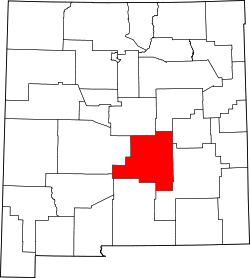Ancho | |
|---|---|
| Coordinates: 33°56′14″N105°44′28″W / 33.9372°N 105.7412°W | |
| Country | United States |
| State | New Mexico |
| County | Lincoln |
| Time zone | UTC-7 (Mountain (MST)) |
| • Summer (DST) | UTC-6 (MDT) |
Ancho is an unincorporated desert hamlet in Lincoln County, New Mexico, United States. It is located west of the Lincoln National Forest, 2 miles east of U.S. Highway 54, and north of the town of Carrizozo. There is an active Presbyterian church at Ancho; however, there are no businesses or services available. Most of the land and historic buildings that were once part of the community-at-large are now on private property and not accessible to the general public.


